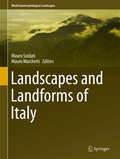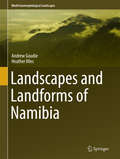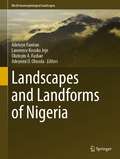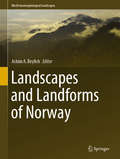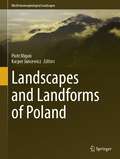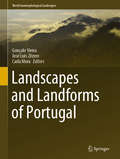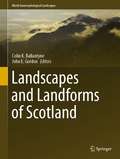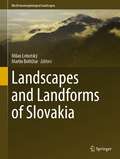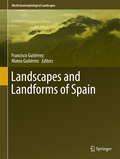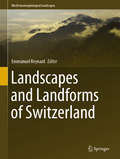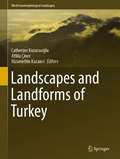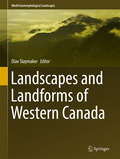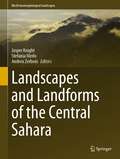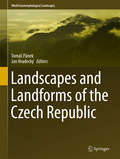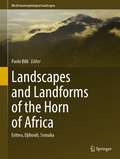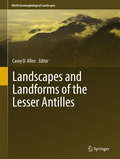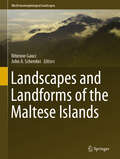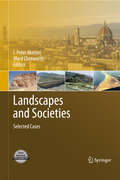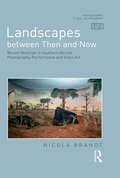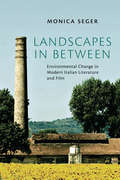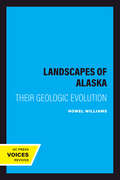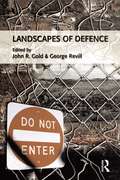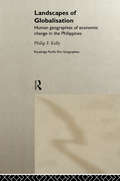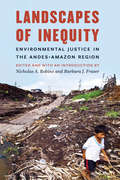- Table View
- List View
Landscapes and Landforms of Italy
by Mauro Soldati Mauro MarchettiThe book deals with the most striking landscapes and landforms of Italy. Attention is given to landform diversity and landscape evolution through time which has been controlled by very diverse geological conditions and dramatic climate changes that have characterized the Italian peninsula and islands since the end of the last glaciation. In addition, various examples of human impact on the landscape are presented. Landscapes and Landforms of Italy contains more than thirty case studies of a multitude of Italian geographical landmarks. The topics and sites described in this book range from the Alpine glaciers to the Etna and Vesuvius volcanoes, taking into account the most representative fluvial, coastal, gravity-induced, karst and structural landscapes of the country. Chapters on the geomorphological landmarks of the cities of Rome and Venice are also included. The book provides the readers with the opportunity to explore the variety of Italian landscapes and landforms through informative texts illustrated with several color maps and photos. This book will be relevant to scientists, scholars and any readers interested in geology, physical geography, geomorphology, landscape tourism, geoheritage and environmental protection.
Landscapes and Landforms of Namibia
by Andrew Goudie Heather VilesThe landscapes of Namibia are of world-class quality in beauty, diversity and interest. This book provides the first ever overview of the most important of these landscapes, explains why they look as they do, and evaluates why they are of note. Writing from a geomorphological perspective, the authors introduce the key processes and controls which influence landscape and landform development in Namibia. Geological and tectonic background, climate now and in the past, vegetation and animals (including humans) are all identified as crucial factors influencing the landscape of Namibia today. The book presents twenty one richly-illustrated case studies of the most significant landscapes of Namibia, ranging from the iconic Etosha Pan at the heart of the biggest wildlife conservation area in the north, to the famous dunes and ephemeral river at Sossus Vlei in the heart of the Namib desert. Each case study also contains a full list of the key references to the scientific work on that landscape. The authors provide an assessment of the current state of conservation of these landscapes, and their importance to tourism. The book is recommended reading for anyone with a professional or amateur interest in the spectacular and intriguing landscapes of this part of southern Africa. It provides a useful handbook for those travelling around Namibia, and an invaluable reference guide for those interested in how landscapes develop and change.
Landscapes and Landforms of Nigeria (World Geomorphological Landscapes)
by Adetoye Faniran Lawrence Kosoko Jeje Olutoyin A. Fashae Adeyemi O. OlusolaThe book deals with the most striking landscapes and landforms of Nigeria. Attention is paid to the diversity of geomorphic features found in the country, from the coast to the extreme north, approached geographically at the national, regional and local scales, with a view to highlight the combined influence of geological, climatic, biotic and anthropogenic influences, as well as geoheritage potentials. The topics and sites described range from the mainly depositional coastal lagoons and inlets, the most prominent of which is the oil rich Niger Delta, characterized by the mangrove and rain forest, both of which have been seriously modified by human impact; through the coastal lowlands and associated hill country, with derived, deciduous and dry forest vegetation; the very prominent Niger/Benue Trough and associated features; the savanna-semi desert covered high plains of the north and the Chad Basin, each of which features spectacular landscapes and landforms, including human-made forms such as cities and cityscapes. The book provides the readers with the opportunity to explore the variety of Nigerian landscapes and landforms through informative texts illustrated with color maps and photos: it will be relevant to scientists/scholars as well as others interested in the geology, physical geography, geomorphology, landscape, tourism and other geoheritage-related information about the country.
Landscapes and Landforms of Norway (World Geomorphological Landscapes)
by Achim A. BeylichThis book discusses the striking geomorphological landscapes of mainland Norway. As part of the Springer book series on World Geomorphological Landscapes, it outlines the nature and diversity of Norway's geomorphological landscapes and examines the geological background and the drivers of landscape evolution. It also features numerous case studies describing the most striking sites, and offers insights into the status and value of geoheritage and geoconservation in the country.Providing readers with an opportunity to explore the variety of Norwegian landscapes and landforms through informative texts richly illustrated with color maps and photos, the book will appeal to scientists, scholars and any readers interested in geology, physical geography, geomorphology, landscape tourism, geoheritage and environmental protection.
Landscapes and Landforms of Poland (World Geomorphological Landscapes)
by Piotr Migoń Kacper JancewiczThe volume is part of World Geomorphological Landscapes series and shows characteristic landscapes and landforms of Poland. It consists of two parts, general and regional. The first part includes overviews of geological history, Quaternary, climate and its impact on landforms, geomorphological division of the country, geoheritage and geoconservation. The second part comprises more nearly 40 region-specific studies to show the diversity of landscapes, from high-mountain relief through medium-altitude forested ranges, limestone uplands and loess plateaus, lowland landscapes moulded by past ice sheets, rivers and aeolian processes, to coastal sceneries. Selected examples of anthropogenically modified landscapes are also considered. Each chapter is accompanied by photographs, maps and diagrams. The volume is intended primarily for geographers and Quaternary geologists, but will be also of interest to anyone interested in natural landscapes and their conservation.
Landscapes and Landforms of Portugal (World Geomorphological Landscapes)
by Gonçalo Vieira José Luís Zêzere Carla MoraThe book brings together contributions from over 35 Portuguese geomorphologists, presenting a thorough overview of the main highlights of the landscape of Portugal's mainland, Azores and Madeira. The book, which is a tribute to Professor António de Brum Ferreira, first President of the Portuguese Association of Geomorphologists and former Professor at the University of Lisbon, who passed away in January 2013, is organized in 3 parts: a) Introduction, which presents a general framework of the physical geography of Portugal, b) Geomorphological landscapes, presenting ca. 30 short papers with regional focus on key geomorphological areas, c) Applied geomorphology, providing an updated vision on the protection of geomorphological heritage with a focus on geoparks, as well as on Geomorphological hazards in Portugal. This first book ever to concentrate on the geomorphology of Portugal will surely become a benchmark for Portuguese geomorphology.
Landscapes and Landforms of Scotland (World Geomorphological Landscapes)
by Colin K. Ballantyne John E. GordonThis book provides an appealing and informative overview of the outstanding landforms and landscapes of Scotland. Scotland is internationally renowned for the diversity of its geology, landforms and landscapes. The rock record spans most of geological time, from the Archaean to the Palaeogene, and represents the outcome of tectonic plate movements, associated geological processes, and sea-level and climate changes. Scotland incorporates primeval gneiss landscapes, the deeply eroded roots of the Caledonian mountain chain, landscapes of extensional tectonics and rifting, and eroded remnants of volcanic complexes that were active when the North Atlantic Ocean opened during the Palaeogene. The present relief reflects uplift and deep weathering during the Cenozoic, strongly modified during successive episodes of Pleistocene glaciation. This striking geodiversity is captured in this book through 29 chapters devoted to the evolution of Scotland’s scenery and locations of outstanding geomorphological significance, including ancient palaeosurfaces, landscapes of glacial erosion and deposition, evidence of postglacial landscape modification by landslides, rivers and wind, and coastal geomorphology. Dedicated chapters focus on Ice Age Scotland and the associated landscapes, which range from alpine-type mountains and areas of selective glacial erosion to ice-moulded and drift-covered lowlands, and incorporate accounts of internationally renowned sites such as the ‘Parallel Roads’ of Glen Roy, the Cairngorm Mountains and the inselbergs of Assynt. Other chapters consider the record of postglacial rock-slope failures, such as the famous landslides of Trotternish on Skye, and the record of fluvial changes since deglaciation. The sea-level history of Scotland is addressed in terms of its raised and submerged shorelines, while several chapters discuss the contrasting coastal landscapes, which range from the spectacular sea cliffs of Shetland and Orkney to the beaches and dunes of eastern Scotland. The role of geoconservation in preserving Scotland’s outstanding geomorphological heritage is outlined in the final chapter. The book offers an up-to-date and richly illustrated reference guide for geomorphologists, other Earth scientists, geographers, conservationists, and all those interested in geology, physical geography, geomorphology, geotourism, geoheritage and environmental protection.
Landscapes and Landforms of Slovakia (World Geomorphological Landscapes)
by Milan Lehotský Martin BoltižiarLandscapes and Landforms of the Slovakia provides an attractive physiographical overview of the most prominent landscapes of Slovakia and the distinctive landforms associated with them. It describes the main driving factors leading to their evolution and importance for geoconservation and geotourism.The richly illustrated book provides the reader with enjoyable and informative descriptions of the selected sites within their regional geographical and geological settings range from the Tatras Mts. with glacially shaped relief as the highest region in the Carpahians to caves and lowlands taking into account fluvial, gravity-induced, karst and structural landscapes of the Slovakia.The book is organized in 3 parts: a) Introduction, which presents a general framework of the physical geography of Slovakia, b) Geomorphological landscapes, presenting papers dealing with key geomorphological areas, resp. landforms, c) Geoheritage and landscape protection, providing an updated vision on the geomorphological/geological heritage sites and landscape protection policy in Slovakia.The book will be relevant to scientists, scholars and any readers interested in geomorphology, geology, physical geography, geoheritage, landscape tourism and environmental protection. It can be also used for undergraduate and graduate courses in Earth and environmental sciences.
Landscapes and Landforms of South Africa
by Jasper Knight Stefan GrabThis book presents a beautifully illustrated overview of the most prominent landscapes of South Africa and the distinctive landforms associated with them. It describes the processes, origins and the environmental significance of those landscapes, including their relationships to human activity of the past and present. The sites described in this book include, amongst others, the Blyde River Canyon, Augrabies Falls, Kruger National Park, Kalahari desert landscapes, the Great Escarpment, Sterkfontein caves and karst system, Table Mountain, Cape winelands, coastal dunes, rocky coasts, Boer War battlefield sites, and Vredefort impact structure. Landscapes and Landforms of South Africa provides a new perspective on South Africa's scenic landscapes by considering their diversity, long and short term histories, and importance for geoconservation and geotourism. This book will be relevant to those interested in the geology, physical geography and history of South Africa, climate change and landscape tourism.
Landscapes and Landforms of Spain
by Francisco Gutiérrez Mateo GutiérrezThe Landscapes and Landforms of Spain provides an informative and inviting overview of the geology and geomorphology of Spain. It incorporates a diverse range of topics, ranging from the fiery landscapes of the Canary Islands and its volcanic formations to the glacial scenery of the Pyrenees. The book devotes attention to granite landforms, karst terrains, coastal dunes and marshes, as well as to heritage and conservation, with the objective of offering the reader a comprehensive insight into the Spanish geological setting. The book presents readers with the opportunity to explore Spanish landforms in detail through its highly illustrated pages and maps, making this an appealing text on the subject field.
Landscapes and Landforms of Switzerland (World Geomorphological Landscapes)
by Emmanuel ReynardThis book provides a comprehensive overview of the Landscapes and Landforms of Switzerland. It covers the country’s geological and tectonic context, together with its climatic context, geomorphological history, structural and karstic landscapes, glacial and periglacial landscapes, landscapes with natural hazards, geomorphology and society, and the preservation of its geomorphological heritage. Richly illustrated, it presents case studies on some of the country’s most famous natural sites, including the Matterhorn, Aletsch Glacier, Sardona Tectonic Arena, and Engadine, among others.
Landscapes and Landforms of Turkey (World Geomorphological Landscapes)
by Catherine Kuzucuoğlu Attila Çiner Nizamettin KazancıThis book on Turkish geomorphology offers location descriptions, based on their dynamics and evolution processes, including hydrology, tectonics, volcanism, slopes, coasts, ice/snow, and wind. It presents landforms as a result of evolution (Quaternary, Holocene, historic) and in relation to the elements determining and/or impacting this evolution (vegetation, soil, hydrology, geology, climate, sea level and human action) as well as the resulting landscapes. Richly illustrated with pictures from each site, including geomorphological maps and sections, it explains the risks associated with the geomorphological dynamics (on local and global scales), natural and/or cultural heritage (archaeology, prehistory, history, architectural specifications adapted to the landscape), as well as challenges for human society (endangered landscape, protection/conservation rules/statutes, posters/paintings.).
Landscapes and Landforms of Western Canada
by Olav SlaymakerThis is the only book to focus on the geomorphological landscapes of Canada West. It outlines the little-appreciated diversity of Canada's landscapes, and the nature of the geomorphological landscape, which deserves wider publicity. Three of the most important geomorphological facts related to Canada are that 90% of its total area emerged from ice-sheet cover relatively recently, from a geological perspective; permafrost underlies 50% of its landmass and the country enjoys the benefits of having three oceans as its borders: the Arctic, Pacific and Atlantic oceans. Canada West is a land of extreme contrasts -- from the rugged Cordillera to the wide open spaces of the Prairies; from the humid west-coast forests to the semi-desert in the interior of British Columbia and from the vast Mackenzie river system of the to small, steep, cascading streams on Vancouver Island. The thickest Canadian permafrost is found in the Yukon and extensive areas of the Cordillera are underlain by sporadic permafrost side-by-side with the never-glaciated plateaus of the Yukon. One of the curiosities of Canada West is the presence of volcanic landforms, extruded through the ice cover of the late Pleistocene and Holocene epochs, which have also left a strong imprint on the landscape. The Mackenzie and Fraser deltas provide the contrast of large river deltas, debouching respectively into the Arctic and Pacific oceans.
Landscapes and Landforms of the Central Sahara (World Geomorphological Landscapes)
by Jasper Knight Stefania Merlo Andrea ZerboniThis book describes the Central Sahara region, bringing together an unprecedented combination of diverse and often historic research published in different languages in order to describe its varied landscapes and landforms. The Central Sahara region consists of Libya, Algeria, Mali, Niger and Chad, countries that share similar landscape histories and common landscape traits, including massifs, sand seas, paleowater features and large depressions. Furthermore, human settlement of this region goes hand-in-hand with climate and environmental changes and landscape evolution during the Holocene and earlier; hence, Central Saharan landscapes and landforms provide valuable insights into landscape–human relationships over long timescales. The book offers a comprehensive yet accessible reference source, drawing on both past and present interdisciplinary research and gathering the insights of authors from many different countries to explore a region that has largely been overlooked in available literature.
Landscapes and Landforms of the Czech Republic
by Tomáš Pánek Jan HradeckýThe book aims to present the unique geomorphological landscapes of the Czech Republic. The geomorphic uniqueness of this country benefits from the proximity to two distinct European geological domains: the old cratonized Bohemian Massif and the relatively young Tertiary fold and thrust belt of the Western Carpathians. Landscapes and Landforms of the Czech Republic introduces general physiographical characteristics of the landscape and presents the main driving factors leading to the evolution of the present landscape. The book contains twenty two chapters describing the most interesting geomorphic landscapes of the Czech Republic. The selection of individual landscapes was based on visual exceptionality (e. g. sandstone landscapes of the Northern Bohemia), scientific importance (e. g. patterned grounds in the Sudetic Mountains) and historical relevance (e. g. mining of the Nízký and Hrubý Jeseník Mountains). The final chapters of the book discuss the protection of geomorphic heritage in the Czech Republic.
Landscapes and Landforms of the Horn of Africa: Eritrea, Djibouti, Somalia (World Geomorphological Landscapes)
by Paolo BilliThis book focuses on regions for which until now the geomorphology was very poorly studied and relatively unknown. Nevertheless, the landforms and landscapes of the Horn of Africa are highly attractive, diverse and in a few cases unique, since they span very different environments, from highland plateaus and mountains to lowlands (even below sea level) and coastlines with a high degree of diversity and from monsoon to arid climate conditions. The main topics addressed in the book include the links between the geological evolution and the current large scale geomorphology of the Horn of Africa; the large differences between the highlands and lowlands climate, river hydrology and their variation through time within a climate change perspective. This part of the world was home of the very first hominids. The landscape in which they lived and evolved throughout the Pleistocene is described in comparison with the arid and inhospitable, though immensely scenic, environment of today. Perennial and ephemeral rivers with very different morphology, processes, and hydrology drain the area, and, in combination with the past and recent uplift, substantially contributed to provide the region with peculiar landscapes and landforms. Long lasting weathering and erosion processes result in a typical inselberg landscape such as the Bur region, or the currently exposed flatland of old peneplain surfaces. Their changes through time, induced by both natural and anthropogenic factors, are addressed by a couple of case studies. Though the region has few inhabitants, they had to struggle to find their livelihood in a land that offers poor resources. This resulted in landscape change and land degradation. Examples of human impact on the landscape are presented at different scales. This book provides readers interested in geography and geomorphology with essential scientific and educational information on the Landscapes and Landforms of Eritrea, Djibouti and Somalia through simple, though scientifically, rigorous texts illustrated with several color maps and photos. One main prerogative of this book is therefore to give an insight into a region of the world where, for geographical and historical constraints, geomorphological investigation was very limited, thus enriching its intrinsic informative value.
Landscapes and Landforms of the Lesser Antilles
by Casey D. AllenThis book focuses on the highly touristed, but surprisingly under-researched Lesser Antilles region. After offering a brief overview of the region's geologic and tectonic history, as well as its basic climatology, subsequent chapters then discuss each island's (or island set's) geomorphology and geology, and how the settlement history, tourism, and hazards have affected their individual landscapes. Written by regional experts and replete with up-to-date information, stunning color imagery, and beautiful cartography (maps), it is the only comprehensive, scientific evaluation of the Lesser Antilles, and serves as the region's definitive reference resource. Accessible to non-experts and amateur explorers, the book includes in-depth discussions and reference sections for each island/island set. Usable as both a textbook and guidebook, it offers readers a straightforward yet detailed assessment of an interesting and intriguing - but often-overlooked and under-appreciated - locale.
Landscapes and Landforms of the Maltese Islands (World Geomorphological Landscapes)
by Ritienne Gauci John A. SchembriThis edited volume brings together a collection of works that comprehensively address both the myriad geomorphological landscapes of the Maltese Islands and how their evolution has been shaped over various time-scales by different sets of processes. Additionally, the work highlights how the small geographical setting of the Maltese Islands helped to closely connect these landscapes with Maltese society and as a result, they have evolved from stand-alone examples of geomorphology to important backdrops of Maltese cultural identity. Most of the contributing authors are academics – both local and foreign – with a research focus on the geomorphology of the Maltese Islands. However, the editors have also (and purposefully) chosen other contributors from governmental institutions and research agencies, who complement the geomorphological research with their proactive work in selected case studies on Maltese landscapes.
Landscapes and Societies
by I. Peter Martini Ward ChesworthThis book contains case histories intended to show how societies and landscapes interact. The range of interest stretches from the small groups of the earliest Neolithic, through Bronze and Iron Age civilizations, to modern nation states. The coexistence is, of its very nature reciprocal, resulting in changes in both society and landscape. In some instances the adaptations may be judged successful in terms of human needs, but failure is common and even the successful cases are ephemeral when judged in the light of history. Comparisons and contrasts between the various cases can be made at various scales from global through inter-regional, to regional and smaller scales. At the global scale, all societies deal with major problems of climate change, sea-level rise, and with ubiquitous problems such as soil erosion and landscape degradation. Inter-regional differences bring out significant detail with one region suffering from drought when another suffers from widespread flooding. For example, desertification in North Africa and the Near East contrasts with the temperate countries of southern Europe where the landscape-effects of deforestation are more obvious. And China and Japan offer an interesting comparison from the standpoint of geological hazards to society - large, unpredictable and massively erosive rivers in the former case, volcanoes and accompanying earthquakes in the latter. Within the North African region localized climatic changes led to abandonment of some desertified areas with successful adjustments in others, with the ultimate evolution into the formative civilization of Egypt, the "Gift of the Nile". At a smaller scale it is instructive to compare the city-states of the Medieval and early Renaissance times that developed in the watershed of a single river, the Arno in Tuscany, and how Pisa, Siena and Florence developed and reached their golden periods at different times depending on their location with regard to proximity to the sea, to the main trunk of the river, or in the adjacent hills. Also noteworthy is the role of technology in opening up opportunities for a society. Consider the Netherlands and how its history has been formed by the technical problem of a populous society dealing with too much water, as an inexorably rising sea threatens their landscape; or the case of communities in Colorado trying to deal with too little water for farmers and domestic users, by bringing their supply over a mountain chain. These and others cases included in the book, provide evidence of the successes, near misses and outright failures that mark our ongoing relationship with landscape throughout the history of Homo sapiens. The hope is that compilations such as this will lead to a better understanding of the issue and provide us with knowledge valuable in planning a sustainable modus vivendi between humanity and landscape for as long as possible. Audience: The book will interest geomorphologists, geologists, geographers, archaeologists, anthropologists, ecologists, environmentalists, historians and others in the academic world. Practically, planners and managers interested in landscape/environmental conditions will find interest in these pages, and more generally the increasingly large body of opinion in the general public, with concerns about Planet Earth, will find much to inform their opinions. Extra material: The color plate section is available at http://extras.springer.com
Landscapes between Then and Now: Recent Histories in Southern African Photography, Performance and Video Art (Photography, Place, Environment)
by Nicola BrandtIn Landscapes Between Then and Now, Nicola Brandt examines the increasingly compelling and diverse cross-disciplinary work of photographers and artists made during the transition from apartheid to post-apartheid and into the contemporary era. By examining specific artworks made in South Africa, Namibia and Angola, Brandt sheds light on established and emerging themes related to aftermath landscapes, embodied histories, (un)belonging, spirituality and memorialization. She shows how landscape and identity are mutually constituted, and profiles this process against the background of the legacy of the acutely racially divisive policies of the apartheid regime that are still reflected on the land. As a signpost throughout the book, Brandt draws on the work of the renowned South African photographer Santu Mofokeng and his critical thinking about landscape. Landscapes Between Then and Now explores how practitioners who engage with identity and their physical environment as a social product might reveal something about the complex and fractured nature of postcolonial and contemporary societies. Through diverse strategies and aesthetics, they comment on inherent structures and epistemologies of power whilst also expressing new and radical forms of self-determinism. Brandt asks why these cross-disciplinary works ranging from social documentary to experimental performance and embodied practices are critical now, and what important possibilities for social and political reflection and engagement they suggest.
Landscapes in Between
by Monica SegerSince its economic boom in the late 1950s, Italy has grappled with the environmental legacy of rapid industrial growth and haphazard urban planning. One notable effect is a preponderance of interstitial landscapes such as abandoned fields, polluted riverbanks, and makeshift urban gardens. Landscapes in Between analyses authors and filmmakers - Italo Calvino, Pier Paolo Pasolini, Gianni Celati, Simona Vinci, and the duo Daniele Ciprì and Franco Maresco - who turn to these spaces as productive models for coming to terms with the modified natural environment.Considering the ways in which sixty years' worth of Italian literary and cinematic representations engage in the ongoing dialogue between nature and culture, Monica Seger contributes to the transnational expansion of environmental humanities. Her book also introduces an ecocritical framework to Italian studies in English. Rejecting a stark dichotomy between human construction and unspoilt nature, Landscapes in Between will be of interest to all those studying the fraught relationship between humanity and environment.
Landscapes of Alaska: Their Geologic Evolution
by Howel WilliamsThis title is part of UC Press's Voices Revived program, which commemorates University of California Press’s mission to seek out and cultivate the brightest minds and give them voice, reach, and impact. Drawing on a backlist dating to 1893, Voices Revived makes high-quality, peer-reviewed scholarship accessible once again using print-on-demand technology. This title was originally published in 1958.
Landscapes of Defence
by George Revill John R. GoldThis is a key text on the very topical themes of power, defence and space. Landscapes of Defence is an exciting collection of theoretical and empirical material from very well known contributors, desiged to help students understand how landscapes of defence fit in with some of the broader concepts of space, power and place to which they are introduced in the 1st year. The book is split into four sections, and each section contains an introduction placing the subsequent chapters in context. There is also a comprehensive introduction and afterword to tie the book's broad themes together. 2nd and 3rd year undergraduates in urban and cultural geography will be the key market for this title, as well as strong secondary market in departments of Sociology, Anthropology, Law and Planning.
Landscapes of Globalization: Human Geographies of Economic Change in the Philippines (Routledge Pacific Rim Geographies)
by Philip F. KellyIn this critical and sophisticated analysis, Philip F. Kelly challenges the conventional definition of globalization as an irresistible and inevitable force to which societies must succumb. By tracing the consequences of global economic integration in the Philippines, he argues that global processes are constituted, accommodated, mediated and resisted in social processes at multiple scales, from the national economy to the village and the household.
Landscapes of Inequity: Environmental Justice in the Andes-Amazon Region
by Nicholas A. Robins Barbara J. FraserThe natural wealth of the Amazon and Andes has long attracted fortune seekers, from explorers, farmers, and gold panners to multimillion-dollar mining, oil and gas, and timber operations. Modern demands for commodities have given rise to new development schemes, including hydroelectric dams, open cast mines, and industrial agricultural operations. The history of human habitation in this region is intimately tied to its rich biodiversity, and the Amazon basin is home to scores of indigenous groups, many of whom have populations so small that their cultural and physical survival is endangered.Landscapes of Inequity explores the debate over rights to and use of resources and addresses fundamental questions that inform the debate in the western Amazon basin, from the Andes Mountains to the tropical lowlands. Beginning with an examination of the divergent conceptual interpretations of environmental justice, the volume explores the issue from two interlocking perspectives: of indigenous peoples and of economic development in a global economy. The volume concludes by examining the efficacy of laws and policies concerning the environment in the region, the viability and range of judicial recourse, and future directions in the field of environmental justice.
